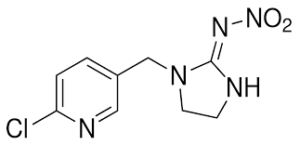Imidacloprid CAS NO 138261-41-3 Inquire about Imidacloprid
Tecoland supplies Imidacloprid bulk active pharmaceutical ingredient (API) to the pharmaceutical industry. Our Imidacloprid is manufactured by cGMP compliant facility. Welcome to contact us for further details including current DMF status for the product and up to date regulatory status of the manufacturing facility. We look forward to assisting you with your research and development projects.
What is Imidacloprid 
Imidacloprid is a systemic insecticide belonging to a class of chemicals called the neonicotinoids which act on the central nervous system of insects. The chemical works by interfering with the transmission of stimuli in the insect nervous system. Specifically, it causes a blockage of the nicotinergic neuronal pathway. By blocking nicotinic acetylcholine receptors, imidacloprid prevents acetylcholine from transmitting impulses between nerves, resulting in the insect’s paralysis and eventual death. It is effective on contact and via stomach action. Because imidacloprid binds much more strongly to insect neuron receptors than to mammal neuron receptors, this insecticide is more toxic to insects than to mammals.
From 1999 through at least 2018, imidacloprid was the most widely used insecticide in the world. Although it is now off patent, the primary manufacturer of this chemical is Bayer CropScience (part of Bayer AG). It is sold under many names for many uses; it can be applied by soil injection, tree injection, application to the skin of the plant, broadcast foliar, ground application as a granular or liquid formulation, or as a pesticide-coated seed treatment. Imidacloprid is widely used for pest control in agriculture. Other uses include application to foundations to prevent termite damage, pest control for gardens and turf, treatment of domestic pets to control fleas, protection of trees from boring insects, and in preservative treatment of some types of lumber products.
Application to trees
When used on trees, it can take 30–60 days to reach the top (depending on the size and height) and enter the leaves in high enough quantities to be effective. Imidacloprid can be found in the trunk, the branches, the twigs, the leaves, the leaflets, and the seeds. Many trees are wind pollinated. But others such as fruit trees, linden, catalpa, and black locust trees are bee and wind pollinated and imidacloprid would likely be found in the flowers in small quantities. Higher doses must be used to control boring insects than other types.
Health effects for Human
The effects of imidacloprid on human health depend on the dose, duration, and frequency of exposure. The effects may also depend on the health of a person and environmental factors. People who might orally ingest acute amounts would experience emesis, diaphoresis, drowsiness and disorientation. This would need to be intentional since a large amount would need to be ingested to experience a toxic reaction.
Disclaimer:
Information on this page is provided for general information purposes. You should not make a clinical treatment decision based on information contained in this page without consulting other references including the package insert of the drug, textbooks and where relevant, expert opinion. We cannot be held responsible for any errors you make in administering drugs mentioned on this page, nor for use of any erroneous information contained on this page.